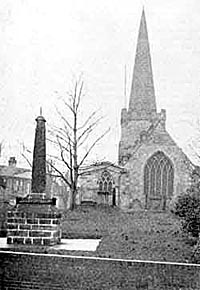< Previous | Contents | Next >
Stapleford Cross
 |
STAPLEFORD CROSS is undoubtedly the most valuable and interesting relic of the past in the county. It is one of those wonderful examples of Anglo-Saxon carving, such as the great crosses at Bewcastle and Eyam that have so much to tell us, of the bygone glories of our Motherland.
The old idea that Saxon England was an uncivilised welter of bloodshed and ignorance has given place to the knowledge that it was the Golden Land of Europe, during the awful centuries that we know as the Dark Ages.
Amongst its kings and law givers, are to be recognised Oswald and Alfred, amongst its scholars Bede and Alcuin, amongst its saints Aidan and Cuthbert, its organisers and missionaries Wilfred and Chad, and amongst its artists the unknown producer of the Lindisfarne Gospels, and these wonderful stone crosses. Stapleford Cross seems to date from about 700, a hundred and seventy years before King Alfred. began his reign, and its weatherworn carvings have been the theme of many appreciative treatises.
The curious horned figure is probably the symbol of St. Luke; and the other three faces of the cross probably displayed the remaining evangelic symbols. How Stapleford Cross came to be erected is a very obscure mystery, but the investigation of it will lead the inquirer into a most interesting and unexpected field of local history.
As an indication of the line of inquiry, it is necessary to bear in mind that in 669, Chad came south from Lindisfarne, bringing the Celtic version of Christianity to heathen Mercia, and settled for a time at Litchfield. Lands in the neighbourhood of Sawley were given to Chad’s Litchfield monastery, and there is Saxon work very evident in Sawley and Breaston Churches, also at Wilne, and a very doubtful tradition of similar work at Long Eaton.
The whole district has been too long neglected, and the time is ripe for a thorough investigation of the neighbourhood.
The Cross was recently removed to the churchyard, from a site in the roadway nearby.
